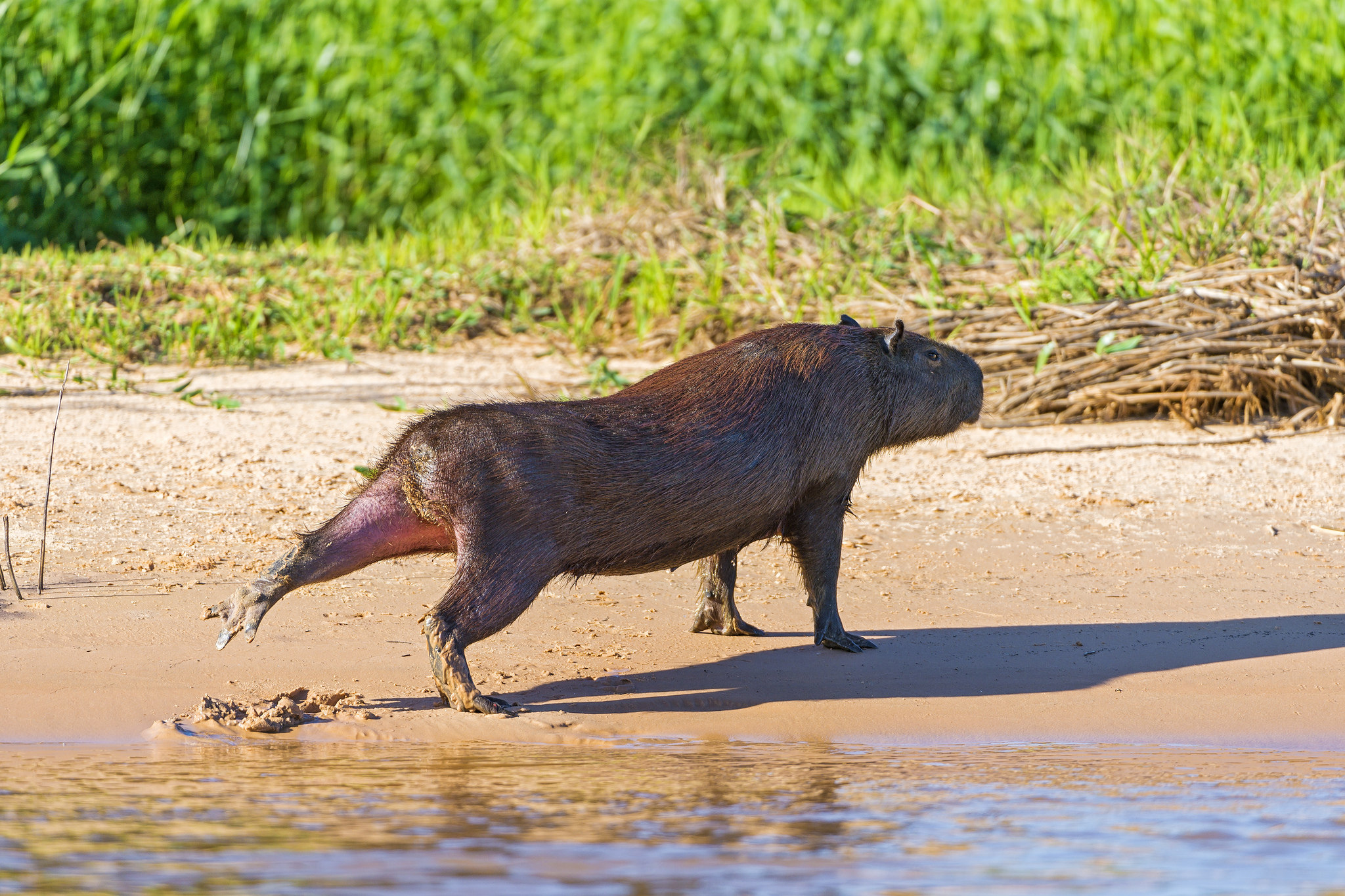The Pantanal in Brazil is the world’s largest tropical wetland spanning over 140,000 square kilometres. It’s a biodiversity hotspot, home to jaguars, capybaras, caimans, and hundreds of bird species. This UNESCO World Heritage site is a paradise for wildlife enthusiasts and photographers. The Pantanal’s vast floodplains, rivers, and lagoons create a unique ecosystem that supports a rich variety of flora and fauna, making it a must-visit destination for nature lovers.
1. Capuchin Monkey
Capuchin monkeys, New World primates of the subfamily Cebinae, are known for their distinctive appearance. They have darkly colored bodies, arms, and legs, with white faces, throats, and chests. Their name comes from the resemblance of their hair to the cowls worn by Capuchin monks. These intelligent monkeys inhabit tropical forests from Nicaragua to Paraguay.
2. Capybara
The capybara (Hydrochoerus hydrochaeris) is a giant cavy rodent native to South America. It holds the title of the largest living rodent and belongs to the genus Hydrochoerus. These semi-aquatic creatures inhabit savannas, dense forests, and areas near water bodies. They’re highly social, often found in groups of 10–20 individuals, and are hunted for their meat and hide.
3. Coatimundi
Coatis, also known as coatimundis, are diurnal mammals native to South America, Central America, Mexico, and the Southwestern United States. They belong to the family Procyonidae and are characterized by their slender heads, elongated noses, and long, non-prehensile tails. Coatis are about the size of a large house cat, with males being larger than females. Their ringed tails resemble those of raccoons, and they often hold them erect to keep troops together in tall vegetation. Locally in Belize, coatis are known as “quash”.
4. Crab Eating Fox
The crab-eating fox (Cerdocyon thous) is a medium-sized canid native to central South America. It’s also known as the forest fox, wood fox, or maikong. Despite its name, this adaptable species primarily consumes a diverse diet, including small mammals, birds, insects, fruits, and carrion.
5. Giant Anteater
The giant anteater (Myrmecophaga tridactyla) is an insectivorous mammal native to Central and South America. It’s the largest of the four anteater species. With its elongated snout, bushy tail, and long fore claws, it forages primarily on ants and termites. Sadly, it’s listed as vulnerable due to habitat destruction and poaching.
6. Giant River Otter
The giant river otter (Pteronura brasiliensis) is a South American carnivorous mammal, also known as the river wolf. It’s the world’s largest otter, reaching up to 6 feet (1.8 metres) in length. These social creatures live in family groups along the Amazon River and in the Pantanal, but their population has significantly declined due to poaching and habitat loss.
7. Howler Monkey
Howler monkeys (genus Alouatta) are the largest New World monkeys, native to tropical areas in Central and South America. They’re known for their roaring cries, which can be heard up to three miles away through dense rainforests. These primates primarily feed on leaves but also play a crucial role as seed dispersers. Threats to their survival include human predation, habitat destruction, and illegal wildlife trade.
8. Jaguar
Jaguars (Panthera onca) are the largest of South America’s big cats and the third largest cats in the world. Their fur is usually tan or orange with black spots, called “rosettes” because they are shaped like roses. Some jaguars are so dark they don’t seem to have spots (melanistic). Their powerful jaws and stocky bodies make them formidable predators. As apex predators, jaguars primarily hunt large mammals such as deer, peccaries, and capybaras. They’re also skilled swimmers and occasionally catch fish or caimans.
9. Tapir
Tapirs inhabit jungle and forest regions of South and Central America as well as Southeast Asia. They are one of three extant branches of Perissodactyla (odd-toed ungulates), alongside equines and rhinoceroses. These herbivorous mammals have short snouts, resembling that of anteaters, which enable them to grab onto branches and leaves. Weighing hundreds of pounds, the tapir is the largest land mammal in South America.
10. Collared Peccary
The collared peccary (Dicotyles tajacu), also known as the javelina, is a species of artiodactyl mammal in the family Tayassuidae. Found in North, Central, and South America, it’s the only member of the genus Dicotyles. These pig-like creatures have a “salt and pepper” coat with a white “collar” around their necks. They weigh between 17 and 30 kg (37–66 lb) and inhabit various habitats, including deserts, grasslands, and forests.
11. Caiman
Caimans are reptiles related to alligators and are usually placed in the family Alligatoridae. They inhabit Central and South America. These amphibious carnivores primarily feed on fish, insects, birds, and small mammals. Due to their large size and ferocious nature, caimans have few natural predators within their environments. Humans, jaguars, anacondas, and crocodiles are their main threats.
12. Tegu Lizard
Tegus are large, carnivorous lizards native to Central and South America. They belong to the families Teiidae and Gymnophthalmidae. These reptiles have aerodynamic bodies, long tails, and strong legs. While most tegus grow to about a metre in length, the black and white tegu can reach up to 1.3 meters. They inhabit various habitats, including rainforests, grasslands, and fields, and are known for their predatory habits.
13. Blue & Yellow Macaw
The blue-and-yellow macaw (Ara ararauna), also known as the blue-and-gold macaw, is a large Neotropical parrot. It boasts a mostly blue topside, a light yellow/orange underside, and gradient hues of green on its head. These striking birds inhabit tropical forests, woodlands, and savannahs across Central and South America, as well as Trinidad in the Caribbean. Their vivid appearance, ability to talk, and close bonding with humans make them popular in aviculture.
14. Piranha
Piranhas are freshwater fish native to South American rivers, streams, lakes, and floodplains. Scientists believe there may be anywhere between 40 and 60 different species. These fish are notorious for their dangerous swarming and flesh-eating behaviour. In reality, most of the time these fish are harmless to humans, many eating fruit.
15. Greater Rhea
The greater rhea (Rhea americana) is a flightless bird native to eastern South America and Southern Chile. Also known as the grey, common, or American rhea, it inhabits open areas like grasslands and savannas. Weighing 20–27 kilograms (44–60 lb), it’s the largest native bird in the Americas. The species is listed as Near Threatened by the IUCN.
16. Hyacinth Macaw
The hyacinth macaw (Anodorhynchus hyacinthinus) is a parrot native to central and eastern South America. With a length of about one metre, it’s longer than any other parrot species. Its striking royal blue plumage, yellow accents around the eyes and beak, and large wings make it a remarkable bird. It’s also the largest flying parrot in the world!
17. Yellow Armadillo
The six-banded armadillo (Euphractus sexcinctus), also known as the yellow armadillo, is found in South America. It’s the sole extant member of its genus and was first described by Swedish zoologist Carl Linnaeus in 1758. These diurnal armadillos are efficient diggers, feed on insects, ants, carrion, and plant material, and inhabit savannas, forests, and shrublands.
18. Female Anhinga
The anhinga (Anhinga anhinga), also known as the snakebird, darter, or water turkey, is a large water bird found in freshwater environments across the Americas. Its name comes from the Brazilian Tupi language, meaning “devil bird” or “snake bird.” Anhingas are skillful swimmers, using their sharp, pointed bills to hunt for fish. They have long necks, fanlike tails, and yellow webbed feet.
19. Great Black Hawk
The great black hawk (Buteogallus urubitinga) is a large bird of prey found in the tropical New World, from Mexico through Central America to Peru, Trinidad, and northern Argentina. Resembling the common black hawk but larger, it inhabits coastal areas, forests, and open woodlands near water.
20. Jabiru Stork
The jabiru (Jabiru mycteria) is a large stork found in the Americas from Mexico to Argentina, except west of the Andes. It sometimes wanders into the United States, usually in Texas, but has also been reported in Mississippi, Oklahoma, and Louisiana. It’s most common in the Pantanal region of Brazil and the Eastern Chaco region of Paraguay. The name “jabiru” comes from the Tupi–Guaraní language and means “swollen neck”.
21. Toco Toucan
The toco toucan (Ramphastos toco) is the largest species of toucan. It boasts a striking appearance with a black body, white throat, chest, and red undertail-coverts. Its most distinctive feature is its massive yellow-orange beak with a black base and large spot on the tip. These toucans inhabit South America, from the Guianas to northern Argentina and Uruguay, and are especially common in Brazilian cerrado, gallery forests, and the Pantanal wetlands.
22. Anaconda
Anacondas, also known as water boas, are a group of large snakes found in tropical South America. The common or green anaconda (Eunectes murinus) is the largest snake by weight and second longest after the reticulated python. It’s non-venomous and semi-aquatic, living near water and feeding on various species, including tapirs and caimans.
Want to see some of the wildlife in the Pantanal? Start planning your trip here.
RELATED: If you are a wildlife lover you shouldn’t miss out on these amazing experiences
Like what you read in this blog? Talk to our travel expert to plan your dream trip to South America
Send message






















